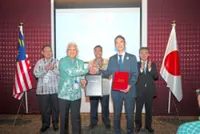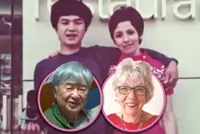The Singapore Pavilion, with a diameter of 18.5m, stands 17m at its tallest. -- PHOTO: AFP
OSAKA (The Straits Times/ANN): Singapore is inviting visitors to its Osaka World Expo pavilion to dream, a fitting pursuit given that the international exhibition is being held on the man-made Yumeshima or Dream Island.
Dreams are necessary to seed change and innovation for a better world, going by the narrative crafted by the Singapore Tourism Board (STB) for its pavilion, which officially opens on April 26.
The Singapore Pavilion, which has been designated as a signature SG60 event to mark Singapore’s 60th year of independence, depicts the indomitable spirit of an island nation that has weathered the odds, with its people sculpting their dreams into tangible realities.
The pavilion’s distinct architecture, a vibrant red globe, is a play on the moniker “Little Red Dot”, which was once intended as a derisive insult of the small city-state but has come to be embraced by Singaporeans as a badge of honour.
Expo 2025, a half-year bonanza of exhibits and experiences with the theme of Designing Future Society for Our Lives, opened its doors to the public on April 13.
But Singapore has saved the formal launch of its pavilion for April 26 to commemorate a special occasion: It is 59 years to the day in 1966 when the Republic established diplomatic ties with Japan. A new orchid is set to be unveiled during the festivities.
The target of the pavilion is to welcome at least one million visitors through its doors over six months, said STB executive director Carrie Kwik, who is in charge of the exhibit.
“We want to inspire them to create their own dreams, contribute these dreams and have them shape the world, by communicating this in an immersive way,” she told The Straits Times.
The $36 million pavilion, which is named the Dream Sphere, carries the tag line Where Dreams Take Shape.
With over 1,700 sq m of floor space, it is 18.5m at its widest and stands 17m at its tallest.
Its striking design and aspirational concept have won bouquets in Japan. The Imperial Household Agency said on April 24 that Princess Aiko, daughter of Emperor Naruhito, will visit the Singapore Pavilion on May 9 during her two-day visit to the Expo.
Within the red globe, multimedia installations and displays by Singaporean artists paint vivid portraits of everyday life in Singapore, showcasing how the island’s rich biodiversity coexists with its people.
On the Dream Repository floor, visitors are invited to pen their dreams on digital canvases which are then projected on a giant screen. They can also take home souvenirs by Singaporean designers, feast on Singaporean foods, and sip on cocktails made from Singaporean craft gin.
But the Expo provides more than an opportunity to showcase Singapore’s progress as a society and nation.
It can also serve as a launch pad for Singaporean brands and start-ups that are keen to expand into Japan, Ms Kwik said, noting the line-up of business events across the six months.
Given that the Expo organisers hope to draw at least 28.2 million people to the jamboree, STB’s goal of a million visitors seems modest.
But attendees are spoilt for choice: Singapore’s is just one of more than 180 pavilions at the festival – spread over an area of 155ha, three times the size of the nearby Universal Studios Japan – which feature exhibits by 158 countries and regions alongside Japanese government entities, companies and commissioned creators.
There are also doubts over whether the Expo would meet its overall attendance target, having been beset with negative headlines over its swelling budget, safety concerns, endless lines owing to poor management, and transportation woes.
Domestic media has pointed out that the event needs to attract an average 150,000 visitors a day to meet its target. But in welcoming its millionth visitor on April 23, it is drawing only an average 91,000 attendees a day.
Questions have also been asked about the raison d’etre of the Expo. Amid bloody wars and trade conflicts and in an interconnected world with an accelerating pace of innovation, is such a festival still relevant?
Japan wants to impress upon the world that it still is. Ms Kwik, too, believes in the value of participating in the Expo, which is also known as the World’s Fair.
“It’s always going to be a world of unknowns and volatility,” she said. “But an event like the Expo presents an opportunity for many countries to showcase, inspire, and contribute something to make the world a little bit brighter and better.”
Even so, the zeitgeist today is very different from that in 1970 when Osaka first hosted the carnival, then themed Progress and Harmony for Mankind, with the event drawing over 64 million visitors.
Japan was then an economic miracle and a technological powerhouse, wowing the world with mobile phones, travelators, magnetic levitation technology and conveyor belt sushi. Today, it struggles with low economic growth and an ageing and shrinking population.
Singapore made its Expo debut that year as a young independent nation; its sprawling 3,000 sq m pavilion occupying prime real estate near the entrance. Going by ST’s reports in 1970, the pavilion’s architects had eschewed showcasing Singapore’s rapid industrialisation in favour of promoting the Republic as a “land of sunshine, palms and blue waters”.
There were live exhibits of crocodiles, tropical birds and fish, with features like a waterfall and attap sheds, as well as slideshows of the pasar malam or night market, dragon dances and Thaipusam.
For 2025, Singapore’s interpretation of the Expo’s overall theme of Designing Future Society for Our Lives again appears abstract compared with those of other countries, which have taken a more literal approach in featuring state-of-the-art innovation.
But Ms Kwik emphasised: “Our story is about inclusiveness. Regardless of background, race, or whether one is able-bodied or a person with disability, everybody can dream and collectively contribute to the Dream Sphere.”
The envisioned ideal future society, she said, is compassionate, inclusive, sustainable and aspirational.
“Ultimately we want to tell people that Singapore is very proud of where we are, but we’re always looking ahead,” she added. “And for Singaporean visitors, I hope it brings them national pride.” - The Straits Times/ANN





